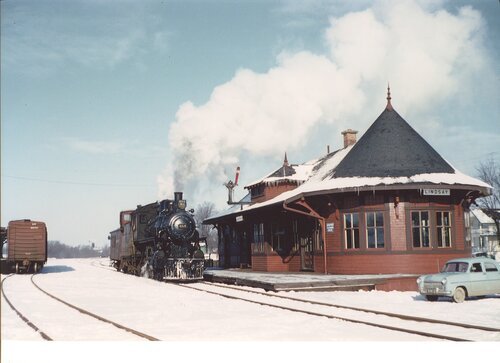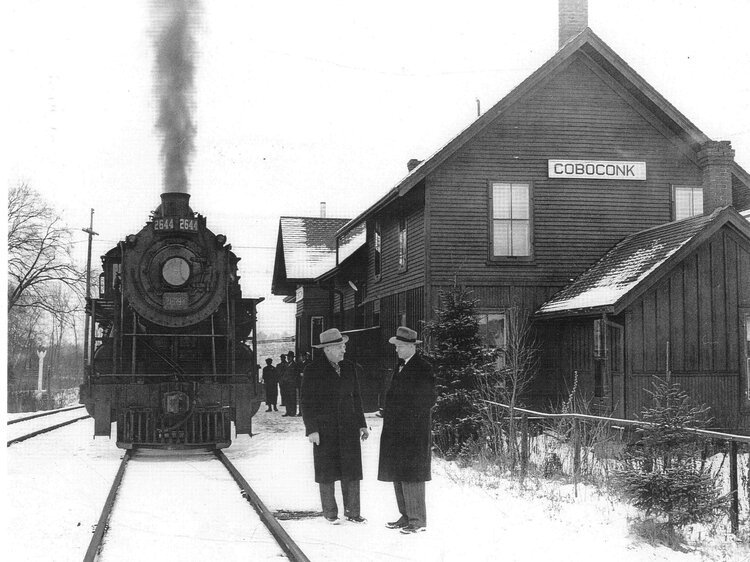Virtual Exhibit:
The Social Importance of Railway Stations in Kawartha Lakes
Past Exhibit: May 2019 to January 2020
This exhibit highlights the social importance of railway stations in Kawartha Lakes.
“The Grand Trunk Railway Station built in 1890 at the south end of William Street was a happy ‘second home’ for me from 1912 to 1960.” - from Railroad Recollections by Charles Heels.
Down at the Station
By 1963, when Lindsay’s Canadian National Pacific station was unceremoniously dismantled, Ontario’s 400-series highways had been in operation for about a decade. In the battle over preferred modes of transportation, the car had won out over the train. To this day, a combination of highway congestion and environmental concerns have seen a resurgence of interest in commuter train travel. Functioning stations remain the gateways to and from many Canadian communities, but they are no longer the hub they once were.
The Hub of a Town
For most Canadians, there is a place in their community where people from all walks of life gather to meet fellow citizens, catch up on the latest in local gossip, and witness events of cultural and historical significance. Long before coffee shops and hockey arenas became popular social hubs, it was the train station where Canadians found their common ground—gathering to share in the sorrow of a departure, the joy of a homecoming, and other noteworthy events.
Nowhere was this more evident than in the former Victoria County. The stations were more than buildings; they served a large variety of functions ranging from the nucleus of communications to being the gateway to and from the world.
Station Architecture
While many of Victoria County’s railway stations were similar in appearance, each of the two major companies serving the region had their own distinctive styles.
Established in 1923, the Canadian National Railway inherited virtually all of its facilities from small branch lines such as the Midland Railway, the Toronto & Nipissing Railway, and the Victoria Railway. Many of these older stations were replaced with newer buildings around the turn of the Twentieth Century. CNR stations were known for their red barn paint, steep gables, and wooden construction.
The Canadian Pacific Railway was built across Victoria County in two stages with the first line opening in 1904 and the second in 1912. CPR stations were generally simple, storey-and-a-half structures with little in the way of ornamentation. The so-called “witch’s hat” station on Caroline Street in Lindsay was an exception. With a conical roof crowning the waiting room, this station served as a local landmark for nearly six decades before being demolished in 1964.
The Social Experience of the Station
Throughout the Nineteenth Century, and well into the Twentieth, the arrival or departure of a train was an exciting occurrence. While the embarking or disembarking of passengers generated a lot of interest, a common freight train could also brew a community’s curiosity. Everything from animals and automobiles, to mail and milk, was shipped by rail.
Stations were at the heart of many a special occasion. Newlyweds were frequently given a flower and rice-laden “send-off” as the train pulled away from the platform. In 1916, some three thousand people from across the county crowded around the CPR station on Caroline Street to bid farewell to the 109th Battalion as it boarded two specially furnished troop trains.
From 1890 to 1923, the Grand Trunk station in Lindsay operated the Grand Trunk Railway’s Literary and Scientific Society. Similar to the mechanic’s literary societies that were early versions of public libraries, the GTR’s society operated a reading room and lending library from the Lindsay station. It was one of four such railway libraries in Canada. The library contained 1600 volumes of books. Hours of operation were 2pm to 5pm and 7pm to 9pm six days a week. The librarian, David Callison Trew (1844-1925), was paid $8 per month. The fee for membership was 5 cents per month. In 1914, a spark from a passing engine set the station's roof on fire. The extent of the damage was to the roof and attic of the building. The greatest loss for the library was to the periodicals on the tables. Trew was quoted in the Watchman-Warder as saying, "The cases saved the books."
Though the stations were generally places where citizens found common ground, they could also reveal a dark side of their communities. Following a divisive hockey match between the Peterborough and Lindsay teams in 1905, “a crowd of fully 200 people gathered at the station and as the [Peterborough] team and their supporters entered the special train they were pelted with snow, chunks of ice, coal, and ‘ancient’ eggs.”






















